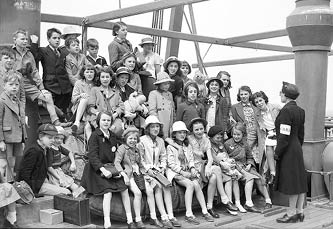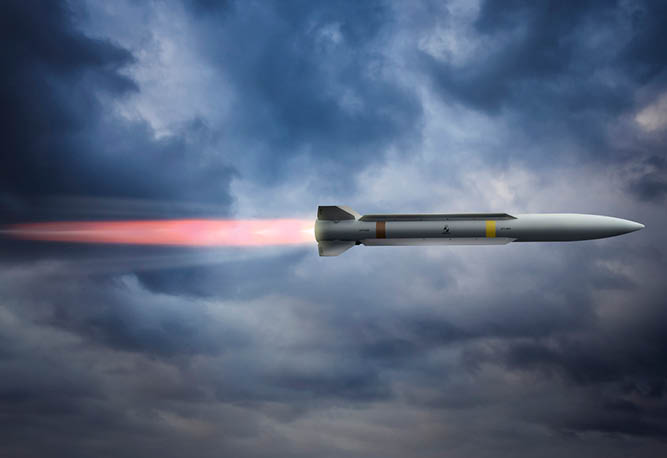Flying Officer George Collins was killed in action at the age of 19. Yet in his adventurous short life, he had circled the globe, joined the RAAF, trained as a navigator, and flown his first operation over Germany.
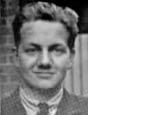
George Barrowby Collins was born on 28 February 1925 in Stockton-on-Tees, County Durham, England. He did well at school and at the age of 15, along with hundreds of children between ages 5 and 15, he was nominated by his relatives in Australia to evacuate war-torn England. The Children’s Overseas Reception Board (CORB) requisitioned the 14,000 ton Polish liner HMT Batory and after several delays due to air raids, the ship sailed from heavily bombed Liverpool on 4 August 1940, with 477 children and 38 escorts. George was given numbered disc 436, which he had to wear at all times. There were also 800 troops on board. Despite wartime secrecy, the Batory was given a rousing dockside farewell.
The Batory was one of 27 ships in the largest convoy to leave Liverpool, and after rounding the north coast of Ireland, she left the main convoy and headed south with Convoy WS2 (Winston’s Specials) and a naval escort. The ships evaded the U boats in the Atlantic, unlike the City of Benares which was torpedoed just a few weeks later, with many children lost. Oblivious to any danger, the Batory children attended lessons, ran a newsletter, joined the Scout or Guide troop, and enjoyed the Crossing the Equator ceremony.
One of the escorts, Meta Maclean, was a pianist and wrote songs for the children, and almost every day the children gathered for a singsong, which could be heard across the waves by other convoy ships. After arriving in Capetown, the Governor General of South Africa, Field Marshal Jan Smuts, hosted a party for the children at Government House. The ship continued its marathon voyage, calling in to Bombay, Colombo, and Singapore, where Army troops disembarked. Unfortunately, during the voyage, George had a fall and was left with a loose right kneecap.
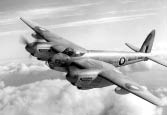
The Batory was already known as the ‘Lucky Ship’ but was soon immortalised as ‘The Singing Ship’ which became the title of the book by Meta Maclean. The Batory arrived in Fremantle on 9 October 1940, where George was met by his Aunt Beatrice, and Uncle George, who was to be his guardian. The young George soon found work at Boans department store, and then in Midland Junction as junior clerk at West Australian Government Railways. He was an outgoing type with a good sense of humour.
With an eye to the sky, George joined 75 Squadron Air Training Corps, Perth in September 1942, and on reaching 18, enlisted in the RAAF on 22 May 1943. He was posted to No.5 Initial Training School, Clontarf, and progressed to No.2 Air Observers School, Mt Gambier, and then No.2 Bombing and Gunnery School at Port Pirie. George was awarded his navigator’s brevet on 2 February 1944.
On 5 March 1944, he embarked at Sydney, bound for the UK. The ship docked in San Francisco, where George was billeted at Fort McDowell. There was time for sightseeing before travelling by train to New York, where he stayed at Fort Slocum and enjoyed his leave amongst the skyscrapers. George then crossed the Atlantic on the HMT Queen Mary, which steamed unescorted at 27 knots and took only 6 days to reach Gourock, Scotland. George disembarked on 17 April 1944, having circled the world.
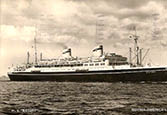
Like most new RAAF arrivals, George was sent to 11 Personnel Despatch & Reception Centre at Brighton, with seafront accommodation at the Metropole Hotel. George was given leave, and as well as sightseeing in London, was able to see his family again. His first posting was to No.3 Advanced Flying Unit at Bobbington, Staffordshire, where he trained on Avro Ansons. George reached a high standard and was selected for No 1655 Mosquito Training Unit, at RAF Warboys, the training base for No 8 Group Pathfinders, headed by Air Vice Marshal Don Bennett. The aptly named airfield took its name from the nearby village of Warboys, twenty miles north of Cambridge.
On 8 December 1944, George was posted to 128 Squadron, based at RAF Wyton, just a few miles from Warboys. The squadron was commanded by Squadron Leader Ivor Broom, known to all as the ‘Flying Broom’. Although part of No 8 Group, 128 Squadron was not used for target marking, and crews were not entitled to the Pathfinder badge. The squadron formed part of Bennett’s Light Night Striking Force (LNSF), which was used for ‘spoof’ raids to divert Luftwaffe night fighters from the main bombing force. It also operated nuisance raids in all kinds of weather, and drove Goebbels to distraction in his Berlin bunker. The usual load for the LNSF Mosquito was a 4,000 lb ‘Cookie’, often adorned with a chalked message to ‘Adolf’.
Just three days later, on 11 December, George flew his first operation. He was crewed with 32-year-old, experienced pilot, Flight Lieutenant Ronald Charles Onley, who had been first violinist with the London Symphony Orchestra, and had featured in BBC broadcasts and the Radio Times. Flying in Mosquito B Mk XVI, s/n MM190 (squadron code M5-C) they took off from RAF Wyton at 1812 hrs to bomb Hamburg, along with 27 other Mosquitos. The B Mk XVI was a pressurised bomber version, with Merlin 72 or 76 engines, a ceiling of 35,000 feet, and a bulged bomb bay to allow for the ‘Cookie’. With its Gee-H radio navigation and H2S ground mapping radar it could navigate and bomb with great accuracy.
Sadly, this was George’s first and last operation, as their Mosquito was reported shot down at 20.04 hrs by 88mm or 128 mm schwere (heavy) flak, which was effective to over 30,000 feet. However, there has been speculation that the Mosquito was the 37th aircraft shot down by night fighter ace Oberleutnant Kurt Welter, flying a ME 262 jet fighter. The Mosquito crashed close to Bokel village, near Bremerhaven. The crash was witnessed by Burgomeister Herr Schoeder, and Frau Stehr, who stated the aircraft approached from the direction of Bremen, circled, and crashed in a field just outside the village. German Army and Luftwaffe personnel reached the crash site soon afterwards and the two airmen were found dead inside the aircraft. The wreckage was removed the next day. Their Mosquito was the only one shot down on the raid.
George Collins and his pilot Ronald Onley were buried in the ‘enemy dead’ section of Bokel parish cemetery. George was only 19, and it had been only four years since he arrived in Fremantle on the ‘Singing Ship’. His father had died just a few weeks before, and his mother later returned to her native Australia. In December 1946, the two airmen were reinterred, side by side, in Becklingen War Cemetery, 13 km south-east of Soltau. George’s headstone reads: ‘In death as in life – steadfast’. Both airmen are commemorated at the International Bomber Command Centre, Lincoln. George is also commemorated on the State War Memorial, Kings Park, Perth; and on the Roll of Honour, Australian War Memorial, Canberra. His name will be projected on the exterior of the AWM Hall of Memory on 6 February 2022.
As for the Batory, the ‘Singing Ship’ gave distinguished service throughout the war, and was finally decommissioned in 1969. RAF Wyton is still active, but RAF Warboys reverted to farmland after 1964. In the Warboys village church of St Mary Magdalene there is a ‘golden eagle’ memorial window to all units of the Pathfinders.
Sources:
NAA – A705, A9301, Collins, George Barrowby
NAUK – AIR 27/932/34:128 Squadron
AWM
Commonwealth War Graves
International Bomber Command Centre
The Singing Ship, Meta Maclean
Reluctant Refuge, thesis, Glen Palmer
Photos previous page
George Collins. NAA. The Singing Ship. Angus & Robertson, 1941



